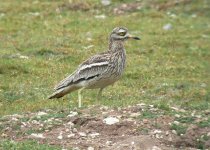Well watched North coast - or is it?
There have been some good birds turn up on the north coast which get a lot of pager coverage, and therefore these areas have been well covered. However, by 'chasing' these birds and trying to catch up with spring migrants in the obvious places (I have been a little guilty of that this year, had to see those pratincoles and ended up making a good day of it on more than one occassion!) I reckon Red Backs and other scarce migrants have landed on the east coast or further inland and have been missed due to lack of observer coverage.
Hi,
Interesting topic as it's been something I've been mulling over for a while. Does the north coast really get covered that well, or is it just the 'hot spots'?
It's been quite interesting the last couple of years as I've made a conscious effort to cover some of the less well known bits of the north coast at migration, and even on days of good conditions for grounding migrants, or even just a sniff of the wind from the 'right' quarter, I'm lucky if I see another birder.
A couple of recent examples: round Brancaster on a day of south easterlies, covering Gipsy Lane marshes, the cover around the Beach Road, churchyard, the dead end footpaths off the Beach Road, the coastal footpath towards Brancaster Staithe, plus some tasty bits nearer the beach / golf course and I was the only birder all day! This barely a mile from Titchwell which presumably was heaving.
Similarly, after Sunday's rain, trundled round Thornham yesterday, all the thick cover along the lane to the harbour, the reedbed, all the trees round the lanes / churchyard, sallows round the pond, recreation ground, thick bushes round the recycling bins and the tasty path along the edge of the marshes. Total number of birders .... 2 (me and Rex!). Total number of migrants zilch but that's another story!
And that's just the tip of the iceberg. I've made a conscious effort this spring (and last autumn) to cover some of the quieter bits of the coast and if I've seen a handful of birders, that's a crowd. And while the Cley area was heaving with birders catching up with the Pratincole etc, the Point was empty.
Don't get me wrong, I quite like wandering round bits of the coast which are empty and birding on my own and I'm sure others would view the thought of 'their' bit suddenly heaving with birders with dismay, but I'm just trying to illustrate a point. Not that I've found anything unusual in my wanderings but it makes me wonder how much is being missed (and I agree with the point above about the east coast and inland). And if people like just going to the hot spots, then good on 'em and if all they do is follow their pager all day, then that's their choice .... although I think Tim once described that very aptly as pagering not birding!
So this autumn, I'm going to continue covering the less popular bits. I'm sure posters on here do exactly the same - not trying to start a bun fight here by accusing anyone of not putting in the effort! But a lot of people seem to think that Norfolk's coast is well covered and I don't think it is. Okay, maybe I'm unlucky with timing and I don't meet all the Norfolk birders out on their patches but I also meet a lot of local birders who, when I ask them where they've been lately, respond with 'oh nowhere really, there's been nowt on the pager'!! Tempting to say well, get off your butts and go and find stuff! Of course there won't be anything on the pager if there's hardly anyone out there looking!
So, having got my big wooden spoon out to stir things up

I'm off to Scotland for a few weeks!
Irene





